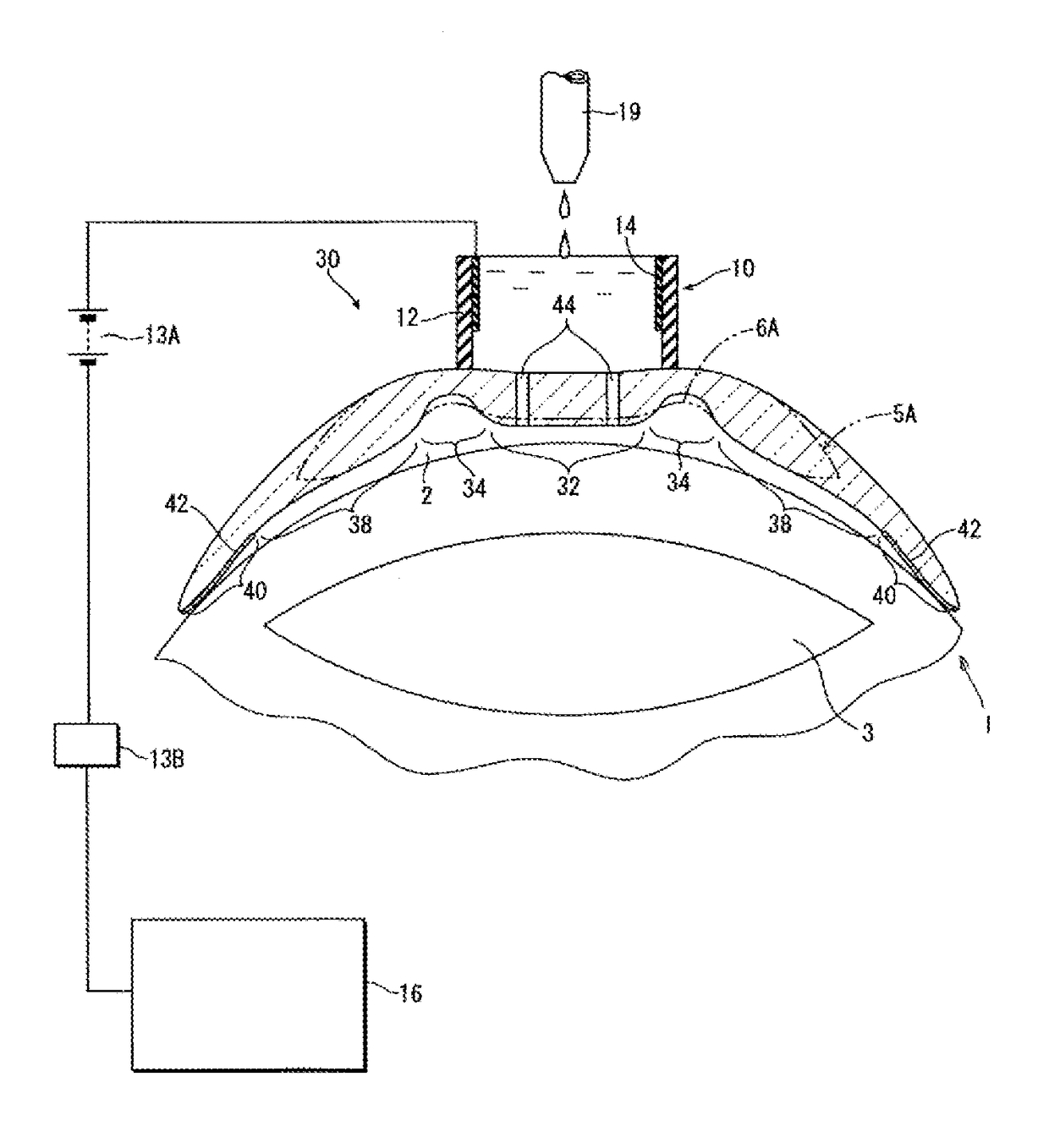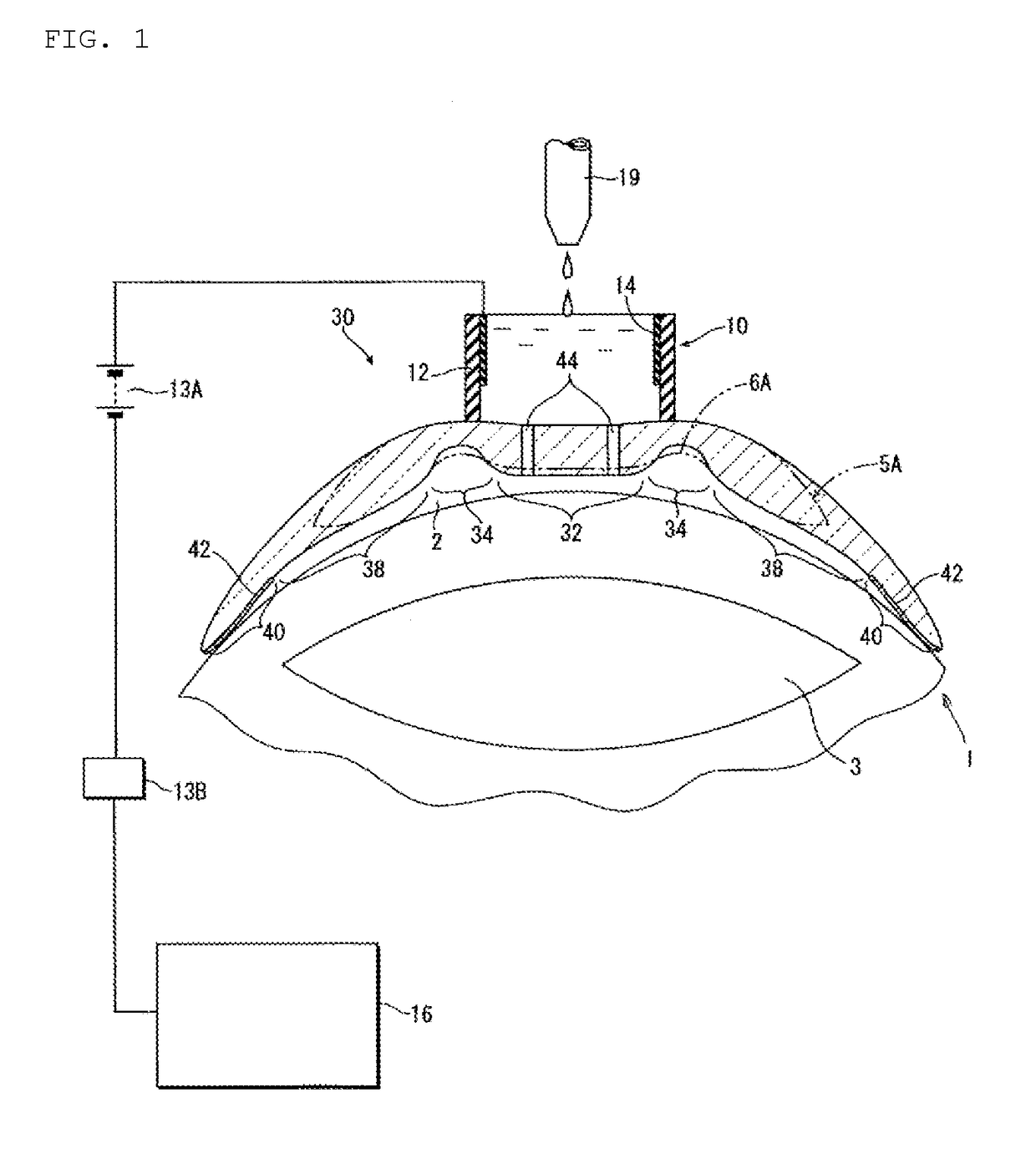Contact lens for cornea-correction crosslinking
a cross-linking and contact lens technology, applied in the field of contact lenses for cornea-correction cross-linking, can solve the problems of cornea-deformation characteristic and inability to sufficiently correct the cornea, and achieve the effect of short tim
- Summary
- Abstract
- Description
- Claims
- Application Information
AI Technical Summary
Benefits of technology
Problems solved by technology
Method used
Image
Examples
example 1
[0038]As shown in FIG. 1, a contact lens for cornea-correction crosslinking (hereinafter referred to as a contact lens) 30 for correcting myopia according to Example 1 of the present invention is used by being mounted on a cornea 2.
[0039]The contact lens 30 is configured to include: a pressing region 32 formed to project in a convex curved-surface shape at a position corresponding to the center of a corneal dome (a front end surface of the cornea 2 having the most protruding portion) to be pressed; a relief region 34 constituted by an annular concave portion having a cross section in a concave circular arc shape, the relief region 34 being formed at a position encircling the outer periphery of the pressing region 32; an anchor region 38 having a shape aligned with a contour 36 (see FIG. 2) of the cornea 2 when the contact lens is mounted on the cornea 2, the anchor region 38 being provided at a position encircling the outer periphery of the relief region 34; and a peripheral portion...
example 2
[0066]Next, a contact lens 130 for correcting hyperopia according to Example 2, shown in FIG. 3, will be described. In FIG. 3, a conventional contact lens 5B for correcting hyperopia is shown by a two-dot chain line.
[0067]The contact lens 130 for correcting hyperopia according to Example 2 has a configuration in which a concave part and a convex part are switched between the pressing region and the relief region as compared to the contact lens 30 shown above in FIG. 1.
[0068]In the contact lens 130 for correcting hyperopia, a relief region 134 is formed in a concave curved-surface shape at a position corresponding to the central area of a corneal dome to be in contact with when the lens 130 is mounted on the cornea 2, and a pressing region 132 is constituted by an annular convex portion having a cross section in a convex circular arc shape and formed at a position encircling the outer periphery of the relief region 134.
[0069]Furthermore, an anchor region 138 is provided at a position...
example 3
[0076]A contact lens for cornea-correction crosslinking 30A for correcting myopia according to Example 3, shown in FIG. 5, is a modified example of the contact lens 30 according to Example 1 and provided with, for example, a light-transmitting conductive film or a light-transmitting metal thin film to serve as an operation-side electrode 14B on the lens surface that is in contact with the reservoir portion 12.
PUM
| Property | Measurement | Unit |
|---|---|---|
| diameter | aaaaa | aaaaa |
| current | aaaaa | aaaaa |
| thickness | aaaaa | aaaaa |
Abstract
Description
Claims
Application Information
 Login to View More
Login to View More - R&D
- Intellectual Property
- Life Sciences
- Materials
- Tech Scout
- Unparalleled Data Quality
- Higher Quality Content
- 60% Fewer Hallucinations
Browse by: Latest US Patents, China's latest patents, Technical Efficacy Thesaurus, Application Domain, Technology Topic, Popular Technical Reports.
© 2025 PatSnap. All rights reserved.Legal|Privacy policy|Modern Slavery Act Transparency Statement|Sitemap|About US| Contact US: help@patsnap.com



